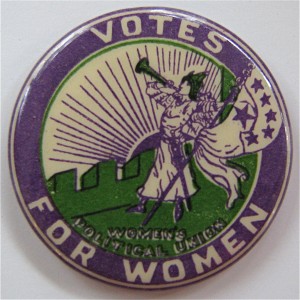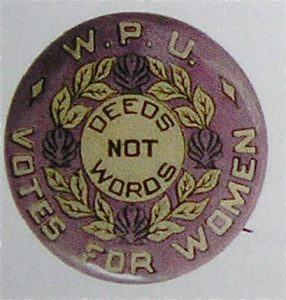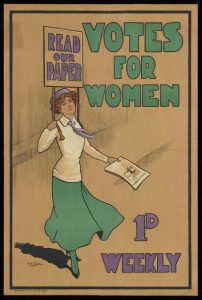The Colors of the Website: Purple, Green and White
“Dignity, Purity, Hope” (The slogan of the British suffragettes)
The color scheme for this website was chosen to pay tribute to the Suffragettes who campaigned for women’s right to vote in England during the early twentieth century. The suffragettes were especially remarkable because they made use of militant tactics in order to gain public attention for their cause. Led by Emmeline Pankhurst (1858-1929) with her two daughters, Christabel and Sylvia, the suffragette organization Women’s Social and Political Union (WSPU), founded in 1903, published their own newspaper entitled Votes for Women since 1907, held rallies, gave speeches, and vandalized public and private property. Many of the suffragettes were arrested, and in prison they engaged in hunger strikes and were subject to forced feeding. Perhaps the most important part of the suffragette movement was that it was intentionally very public. Critics of the suffragettes encourage them to work “within the system” an “obey the laws,” but in her speech “Why We Are Militant,” Emmeline Pankhurst points out that women had been working within the system for too long without seeing any results. Pankhurst instead encourages women to cause a scene so that they could no longer be ignored or pushed aside. She also criticizes the double standards held against women for their impatience and their aggressive tactics, reminding the public that men do not face the same criticism when they adopt the same tactics.
As the suffragette movement grew, it became important for the women of the movement to be recognizable, leading to the importance of the suffragette colors. Purple, green, and white were first used as colors representing the suffragettes at Women’s Sunday in June of 1908. The intention was to bring visual unity to the demonstration and meeting, which took place in London Hyde Park. The color scheme was developed by Emmeline Pethick Lawrence (1867-1954), a wealthy supporter of the WSPU, and was supposed to represent dignity, purity, and hope. In addition to bringing a visual unity to the suffragette movement, this color scheme promoted a more positive image of suffragettes as individuals, whose violent tactics increasingly earned them a reputation as “unfeminine,” unrefined and “frumpy” in the contemporary public. Soon after the color scheme was introduced, merchandise of all kinds was produced in purple, green, and white, which helped with the publicity and funding of the movement. Women were encouraged to dress or wear sashes, buttons, and ribbons in these colors. Very quickly, purple, green, and white spread across the suffragette movement, making their politics visible in all aspects of public and private life.
It is important to remember the suffragettes for their persistence, their enthusiasm, and their unity. Although their militant tactics of civil disobedience were controversial, they certainly succeeded in drawing attention to the needs and opinions of women, which were so frequently ignored. Unfortunately, women all over the world continue to lack the same influence in politics in society that men have. Their voices continue to be ignored, and their efforts for change are brushed aside. The suffragettes illustrate the importance of perseverance, and the need to be creative and organized with one’s efforts for change. As women in England during the early 20th century rallied in purple, green, and white, women today continue to rally together to promote the rights of women. This unity and strength must be remembered.
Sophie Nachmann, Computer Science Major, Women and Gender Studies Minor, Class of 2021
Sources
Literature and Websites
- Bell, Susan Groag, and Karen M Offen. In Women, the Family, and Freedom: The Debate in Documents, vol.2, 233–245. Stanford, California: Stanford University Press, 1983.
- DiCaprio, Lisa and Merry E. Wiesner. “Emmeline Pankhurst ‘Why We Are Militant.’” In Lives and Voices: Sources in European Women’s History, 387–393. Boston, MA: Houghton Mifflin Company, 2001.
- Mercer, John, “Media and Militancy: Propaganda in the Women’s Social and Political Union’s Campaign,” Women’s History Review, 14, no. 3-4, (2006): 471-486.
- Pankhurst, Emmeline. My Own Story (1914). London: Virago Limited, 1979.



